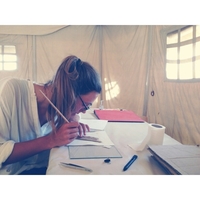Collège de France, 28 septembre 2023
Research Interests:
Collège de France, 7 décembre 2022
Research Interests:
Collège de France, 19-20 septembre 2022
Research Interests:
The ongoing edition (dir. T. Hickey, Univ. of California, Berkeley, and J.-L. Fournet, Collège de France/EPHE) of an unpublished codex of wooden tablets from the British Library (Add. Ms. 33369), has raised many questions about its... more
The ongoing edition (dir. T. Hickey, Univ. of California, Berkeley, and J.-L. Fournet, Collège de France/EPHE) of an unpublished codex of wooden tablets from the British Library (Add. Ms. 33369), has raised many questions about its context of use. The tablets contain indeed copies of various model texts (leases, sales on delivery, loans of money, deed of surety, petition, accounts) used as writing exercises by someone who was presumably trained to be able to draw proficient documentary scripts in his future professional activities – like a notary, a business agent or a professional scribe –, in the late fifth-century Panopolis. However, whereas one would expect that the apprentice would already have acquired high professional skills at this point of the training process, the hand and the different kinds of mistakes we find all over the texts suggest that the apprentice was actually still in a very elementary stage of training.
As the literature on the subject of “specialized schools” (R. Cribiore, Gymnastics of the mind, p. 182-183) is quite poor, this paper aims at giving an overview of parallel evidence in order to put the BL tablets in a broader perspective. Thus, it starts with a presentation of the characteristics of the BL codex (formulas, palaeography, literacy), and then presents the parallel texts of model contracts on wooden tablets as potential evidence for the existence of scribal schools in the same period (mid 4-5th cent.). Eventually, leaning on the analysis of edited schoolbooks from the 6th and 7th centuries, it tries to reshape the educational program which the apprentices may have followed in those schools, from the earliest steps which the BL tablets contribute now to enlighten, to the better-known advanced levels.
As the literature on the subject of “specialized schools” (R. Cribiore, Gymnastics of the mind, p. 182-183) is quite poor, this paper aims at giving an overview of parallel evidence in order to put the BL tablets in a broader perspective. Thus, it starts with a presentation of the characteristics of the BL codex (formulas, palaeography, literacy), and then presents the parallel texts of model contracts on wooden tablets as potential evidence for the existence of scribal schools in the same period (mid 4-5th cent.). Eventually, leaning on the analysis of edited schoolbooks from the 6th and 7th centuries, it tries to reshape the educational program which the apprentices may have followed in those schools, from the earliest steps which the BL tablets contribute now to enlighten, to the better-known advanced levels.
Research Interests:
Séminaire d’Histoire et d’Archéologie des Mondes Orientaux 2019 « Regards croisés sur l’économie végétale du Soudan à la Mésopotamie », coordonné par Cécile Michel SHAMO 2019, MAE, 14 mars 2019
Si le terme ἐρείκη n’apparaît guère dans la documentation papyrologique en dehors des textes médicaux, on rencontre son dérivé ἐρίκινος dans divers types de textes à partir de la fin du Ier s. ap. J.-C. pour désigner l’essence d’un arbre... more
Si le terme ἐρείκη n’apparaît guère dans la documentation papyrologique en dehors des textes médicaux, on rencontre son dérivé ἐρίκινος dans divers types de textes à partir de la fin du Ier s. ap. J.-C. pour désigner l’essence d’un arbre dont la végétation semble spontanée en Égypte et le bois d’utilisation courante. Or le LSJ Greek-English Lexicon et le Wörterbuch de Preisigke ne proposent d’autre traduction que : « heath, Erica arborea » et « Erikaholz », renvoyant à un genre arborescent de bruyère certes répandu en zone méditerranéenne mais dont la présence en Égypte n’est pas attestée par les analyses archéobotaniques. Objet d’embarras jusque là, la question s’éclaire néanmoins grâce à un nouvel examen des sources papyrologiques, littéraires et lexicographiques croisées avec les données archéobotaniques.
L’identification de cette essence permettra ainsi de mettre en évidence et d’interroger une évolution lexicale du grec à l’époque romaine mais aussi d’envisager sous un jour nouveau les enjeux environnementaux et économiques qui lui sont liés.
L’identification de cette essence permettra ainsi de mettre en évidence et d’interroger une évolution lexicale du grec à l’époque romaine mais aussi d’envisager sous un jour nouveau les enjeux environnementaux et économiques qui lui sont liés.
